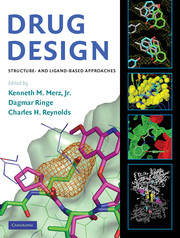Book contents
- Frontmatter
- Contents
- Contributors
- Preface
- DRUG DESIGN
- 1 Progress and issues for computationally guided lead discovery and optimization
- PART I STRUCTURAL BIOLOGY
- PART II COMPUTATIONAL CHEMISTRY METHODOLOGY
- PART III APPLICATIONS TO DRUG DISCOVERY
- 12 Computer-aided drug design: a practical guide to protein-structure-based modeling
- 13 Structure-based drug design case study: p38
- 14 Structure-based design of novel P2-P4 macrocyclic inhibitors of hepatitis C NS3/4A protease
- 15 Purine nucleoside phosphorylases as targets for transition-state analog design
- 16 GPCR 3D modeling
- 17 Structure-based design of potent glycogen phosphorylase inhibitors
- Index
- References
17 - Structure-based design of potent glycogen phosphorylase inhibitors
from PART III - APPLICATIONS TO DRUG DISCOVERY
Published online by Cambridge University Press: 06 July 2010
- Frontmatter
- Contents
- Contributors
- Preface
- DRUG DESIGN
- 1 Progress and issues for computationally guided lead discovery and optimization
- PART I STRUCTURAL BIOLOGY
- PART II COMPUTATIONAL CHEMISTRY METHODOLOGY
- PART III APPLICATIONS TO DRUG DISCOVERY
- 12 Computer-aided drug design: a practical guide to protein-structure-based modeling
- 13 Structure-based drug design case study: p38
- 14 Structure-based design of novel P2-P4 macrocyclic inhibitors of hepatitis C NS3/4A protease
- 15 Purine nucleoside phosphorylases as targets for transition-state analog design
- 16 GPCR 3D modeling
- 17 Structure-based design of potent glycogen phosphorylase inhibitors
- Index
- References
Summary
INTRODUCTION
Diabetes is a disorder of metabolism and is widely recognized as one of the leading causes of death and disability. It is estimated that more than 180 million people worldwide have diabetes. In the United States, more than 20 million people – about 7.0% of the population – have diabetes. Diabetes is a lifelong condition that, if left untreated, can lead to serious complications such as nerve damage, kidney failure, blindness, and cardiovascular diseases. Type 2 diabetes is a chronic metabolic disorder characterized by fed and fasting hyperglycemia. Glycogen phosphorylase (GP) is a key enzyme in the regulation of glycogen metabolism by catalyzing the breakdown of glycogen to glucose-1-phosphate. In muscle, glucose 1-phosphate is used to generate metabolic energy, whereas in liver it is also converted to glucose for export to peripheral tissues. There are three human isozymes of GP: liver, muscle, and brain, named to denote the tissues in which they are preferentially expressed. The muscle and brain isozymes serve the tissues in which they are found, whereas the liver isozyme meets the glycemic demands of the body as a whole. Previous reports have indicated that GP inhibition can lower blood glucose in diabetic models, thus validating it as a potential therapeutic target for treatment of type 2 diabetes. The liver isozyme of human glycogen phosphorylase (HLGP) is considered to be the preferred target for therapeutic intervention with GP inhibitors because inhibition of muscle or brain GP could lead to undesirable side effects.
- Type
- Chapter
- Information
- Drug DesignStructure- and Ligand-Based Approaches, pp. 257 - 264Publisher: Cambridge University PressPrint publication year: 2010



